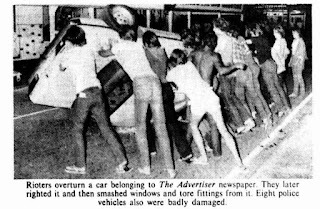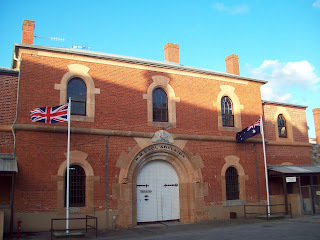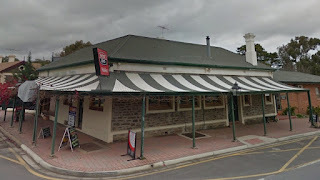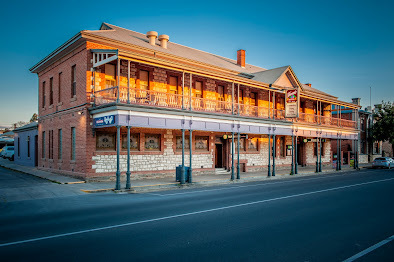Allen Tiller's Blog, page 11
January 30, 2023
Glenelg Riot – January 1984 – part two.
On Tuesday, January 24, 1984, just two days after the Glenelg riots, thieves broke into the explosives magazine of Quarry’s Industries ltd at Hillbank, in Adelaide’s northern suburbs. Using oxy-acetylene equipment, they cut through the hinges and padlocks on the building between 5pm and 8pm that evening.
The thieves stole four cases of gelignite, around 64 sticks of the volatile explosive, and detonators.
Elizabeth CIB attended the scene and found a handwritten note which read, "Thank you, now watch out cops at Glenelg."
A direct threat to the police station and star force officers that attended the riots on January 22nd.
 Rioters overturning a car at Glenelg in 1984.
Rioters overturning a car at Glenelg in 1984.
researched and written by Allen Tiller © 2023
'Gelignite thieves' threat taken seriously by police', The Canberra Times, (26 January 1984), p. 6.
January 23, 2023
Glenelg Riot – January 1984 – part one.
On January 22, 1984, bands, Pseudo Echo and Sandy and the Sunsets were scheduled to play at Colley Reserve, Glenelg. It was a hot day, 15000 people descended on the reserve for the free concert sponsored by radio station SA: FM.
The crows were reasonably well-behaved until, as reported in the Canberra Times, the police started making arrests. At around 6pm, the mood in the crowd changed and chants of “Kill the pigs” and “kill the coppers” began as the restless crowd surged towards the police.
The police reported that 200 or so people began charging the police at Colley Reserve, throwing beer bottles at them, and screaming abuse. Cars were damaged in a side street, and a group of police officers were besieged, locked inside the Glenelg police station. A local senior citizens centre had 23 windows smashed. Two police officers were treated for head wounds. Sixty-three people were charged with offences ranging from drunkenness and assault to malicious damage.
The New South Wales newspaper Tribune, reported on the riot, interviewing eyewitnesses to the event. One witness, Stephanie Columbus stated about the riots, “The first thing to emphasise is that no trouble occurred until the concert was finished, and most of the 15, 000 people had left the area. The concert was very relaxed. It is true that lots of booze was being drunk.”
Columbus and another witness, Carol Jacobson claimed that a few young men had been having an ice fight, throwing ice and water at each other. Some hit a police officer, who, with three other officers, grabbed one of the men and slammed his head into the bonnet of a car four times in front of the crowd. This claimed the witnesses were the trigger for the riot. The crowd started pelting the offending officers with bottles. The police arrested another young man, again being brutal in the arrest, and sending the crowd into a further uproar.
Stephanie then claimed that,
From then on it was a situation of the police imposing their power and authority at will. There could be no talking to them, to them everybody was the enemy.
For instance, a police officer and his dog passed by an onlooker who seemed to unthinkingly stroke the dog. The officer immediately kicked him in the shins and gave him a karate chop to the throat. When I protested about someone else being forced to move on, a policeman said: 'You shut up, slut, or you'll be arrested next.
It is claimed that during the riot, police officers removed their numbers so no reports of police violence could be claimed against them. It is also claimed that police entirely surrounded the reserve so people could not leave, adding further fire to the rioter’s cause.
A few days after the riot, the State Government became involved, putting a political spin on the event, and blaming the riot on unemployed people. Interestingly, at the time of the riot, the Police Association President was vocal about a review of the Police Offences Act which could lead to a weakening of police powers to move on disorderly youths.
In the weeks after the riot T-shirts with the slogan ‘Come to Glenelg…it’s a riot’ began to be seen around Glenelg.
This is not the end of this story…. next week, a chilling conclusion to the Glenelg Riots!
Researched and written by Allen Tiller © 2023'Four-hour rampage after rock concert', The Canberra Times, (24 January 1984), p. 3.
'Four-hour rampage after rock concert', The Canberra Times, (24 January 1984), p. 3.
'Glenelg clash shakes Adelaide's complacency on jobless', Tribune, (8 February 1984), p. 16.
'Glenelg clash shakes Adelaide's complacency on jobless', Tribune, (8 February 1984), p. 16.
October 18, 2022
The Loxton Beast

In 1908, the Loxton Beast raised its head and caused concern near the Riverland settlement. The Renmark Pioneer reported that people were too scared to leave their homes at night for fear of running into the tiger near Mr Alwege’s property.
The tiger had been seen near the rear of Alwege’s farm, with reports that horses, cats, and dogs would not stop in the vicinity for fear of being hunted by the beast. A posse of local men was formed to hunt the beast.It is not known if they captured it, but as it was not reported in local newspapers, one can assume they did not!
In early 1919, Loxton farmer, Arthur McCourt publicly claimed he had been working his farm when he spied what he believed to be a jaguar on his property.A correspondent for the Murray Pioneer and Australian River Record newspaper (Renmark), called for a hunting party to be formed to pursue the jaguar, and ‘to hunt the animal down.’
This was not the first time McCourt, who had previously lived in Tantanoola, home of the infamous Tantanoola Tiger and other thylacine sightings, had gone public with his claims. It is implied in the Murray Pioneer and Australian River Record newspaper, published on 7 March 1919, that McCourt was associated with cattle rustlers who were found guilty of starting rumours around Tantanoola that the beast had returned. These rustlers were captured and sent to prison.
Whether it was cattle rustlers or a genuine sighting of a jaguar, or a thylacine at Loxton remains undetermined. It is however an interesting story. I would love to hear from Loxton residents if their grandparents ever spoke of the Loxton Beast…
Researched and written by Allen Tiller 2022.
'The Loxton "Tiger."', Renmark Pioneer, (26 June 1908), p. 2., http://nla.gov.au/nla.news-article109....
'Loxton's Jaguar.', The Mail, (22 February 1919), p. 2., http://nla.gov.au/nla.news-article637....
'Loxton.', Murray Pioneer and Australian River Record, (7 February 1919), p. 6., http://nla.gov.au/nla.news-article109....
'The South East.', Murray Pioneer and Australian River Record, (7 March 1919), p. 3., http://nla.gov.au/nla.news-article109...
October 11, 2022
Angle Vale Road Ghost

Recent reports have come in regarding the sighting of the ghost of a man walking his dog on Angle Vale Road, Angle Vale.
Witnesses have been driving along Angle Vale Road at dusk, and sometimes late at night when seeing the alleged ghost. The man and dog are walking in the middle of the street. He appears solid but vanishes before the witnesses’ eyes.
If you have witnessed this ghost, we would like to hear your story… please contact us.
August 16, 2022
The Execution of Joseph Stagg

Joseph Stagg was executed at the Old Adelaide Gaol on 19 November 1840. Portable gallows were erected at the front gates of the gaol, and at 8 am, Stagg was hung in front of 700 spectators. Stagg was found guilty of murdering John Gafton at what is now Port Gawler.
Mrs Robertson, a resident near the Gawler River was approached by a man asking for a loaf of bread. He and his friends had not eaten for three days, and they were hoping for some charity. He offered her half a sovereign for the loaf. Robertson grew suspicious of Gafton and his cohorts, and at her first available opportunity, reported him and his friends to the local police constable.
Mounted police were sent to the area. They had been searching for three wanted cattle rustlers; Gafton, Fenton and Best.
Aboriginal trackers were employed who were able to track down the men’s campsite.
The trackers had led police to a small, recently constructed hut. Inside lay the lifeless body of John Gafton. Well known to police, Gafton had recently escaped gaol. He was found to have a gunshot wound behind one of his ears. In his pocket were 11 sovereigns, but no pistol could be found in the hut.
The Coroner and two jurymen were called to the murder site to collect the body and gather evidence. A known accomplice of Gafton, Joseph Stagg was accused of the crime and a warrant for his arrest was issued.
Stagg was apprehended by Constable Lomas and taken to the local police station where he was searched. In his possession were 16 pounds, several percussion caps, and paperwork that related to transactions between Stagg and Gafton regarding their recent cattle rustling.
Also in Stagg’s possession was a pistol, which was identified by Mrs Robertson as the one being in the possession of Gafton, the young man who had first begged her for the loaf of bread.
Stagg declared his innocence. All the evidence was circumstantial, but still, he was found guilty of murder and sentenced to execution.
His final days were taken up with him reading the bible.
The night before his execution, he was taken to the Police Horse Barracks, to be separated from the general population, and returned the morning of his execution.
August 9, 2022
A Haunting at the Greenock Hotel

The original Greenock Hotel was located on the other side of the road from the one we see today. It was moved to its current location in 1956 by Mr G.E. Schluter into a house and corner shop that was once the General Cash Store, built in the 1850s by James Jackman.
Prior to the hotel, the building had also been used as the local post office.
In the 1960s a young married couple went to stay at the hotel with the new husband’s aunt. After closing, the couple retired to their bedroom. The newlywed wife awoke and went into the kitchen for a drink of water. As she passed the former living room, now a lounge, she witnessed a large coffin draped in black cloth and a host of people dressed in black standing around the coffin, silently weeping.
Over the years, other guests have also witnessed the same mourning event in the room.
Guests have also reported small objects, like keys going missing, only to find them in another place, far from where they knew they had been placed. Cold spots and doors opening and closing of their own volition are also reported.
August 2, 2022
A Haunting at the Tanunda Hotel
A Haunting at the Tanunda Hotel
The Tanunda hotel was built circa 1845 and was first licensed in 1847. In 1905 a fire severely damaged the building, so it was rebuilt. A second story built of Angaston marble was also added, and a balcony was imported from England, finishing the look it has today.
It is claimed that apparitions stalk its hallways, and disembodied footsteps can be heard walking into the bedrooms. One witness claims he awoke in his bedroom with a group of ghosts standing around staring at him. The witness believed that the ghosts followed him from the Langmiel Lutheran Cemetery just a little further south of the hotel after an evening of ghost hunting.
 visit the Tanunda hotel at: https://www.tanundahotel.com.au/
visit the Tanunda hotel at: https://www.tanundahotel.com.au/July 26, 2022
A Shot of Spirits. Ep 21. Mallala Hotel - South Australia
The Mallala Hotel is alleged to be haunted by a ghost named George. The Mallala Hotel was built in 1872 by Peter Farrelly, with his sister, Mrs Kelly being the first licensee. The second licensee was my great-great-grandfather, George Tiller. Another George to operate the hotel was George Reddaway in 1879… This hotels ghost has been dubbed George, which is the most common name used to dub pub ghosts. George the ghost has been known to slam doors, make lights flicker, and let out the odd groan on occasion
July 19, 2022
The Tramway Museum St Kilda.
The Tramway Museum St Kilda.
The Tramway Museum St Kilda. St Kilda Road. Open Sundays: 12 Noon until 5 pm. https://www.trammuseumadelaide.com/
-Start transcript- In 1954, the South Australian branch of the Australian Electric Traction Association was formed. The A.E.T.A advocated for the retention and expansion of electric transport systems.
In 1957, the South Australian branch of the A.E.T.A. formed the SA Branch Australian Electric Transport Museum. Later they incorporated as the Australian Electric Transport Museum (SA) Inc.- now better known as the Tramway Museum at St. Kilda.
In 1958, the site of the former St Kilda Primary School became the storage home of Trams No. 1, 111, 192 and 42. In July 1962 the museum opened as a static display.
In 1972, the Salisbury Council, via government grant, built the tram line from the museum to St Kilda Beach, with volunteers building the overhead system. The tramway was officially opened in March 1974, with Tram No.1 leading the procession, the same tram used to open the Adelaide tramway in 1909. The museum currently has 26 trams, 5 trolly buses, two-horse trams, a horsebox and lots of displays showcasing Adelaide’s tramway history! The museum is run entirely by dedicated volunteers. The Tramway Museum is located on St Kilda Road, St Kilda, on the way to the St Kilda Playground. The facility is wheelchair accessible.
Trams leave the museum for St Kilda Playground every half hour. Your admission into the museum gives you unlimited tram rides for the day, with three different trams running consecutively every session.
The museum is open every Sunday from 12 noon until 5pm. -end transcript. Information sourced from the Tramway Museum website.
July 12, 2022
A Shot of Spirits: Ep 20 - Hahndorf Academy - South Australia
A Shot of Spirits: Ep 20 - Hahndorf Academy - South Australia



